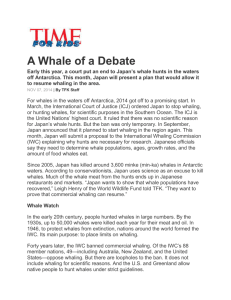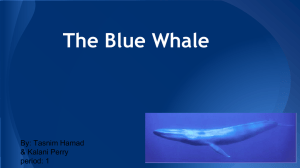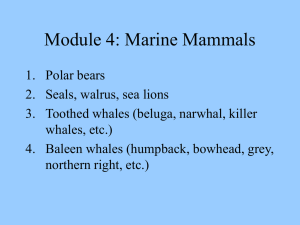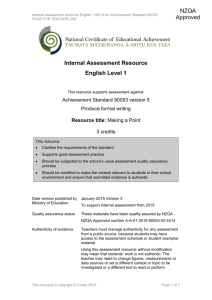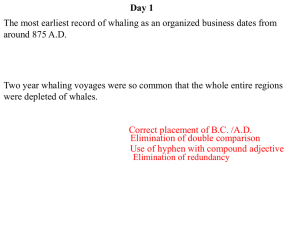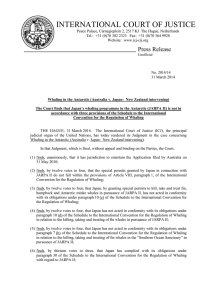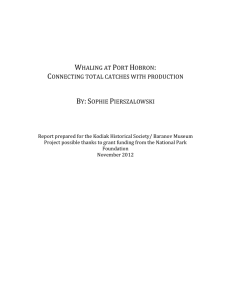How is Japanese whaling?
advertisement
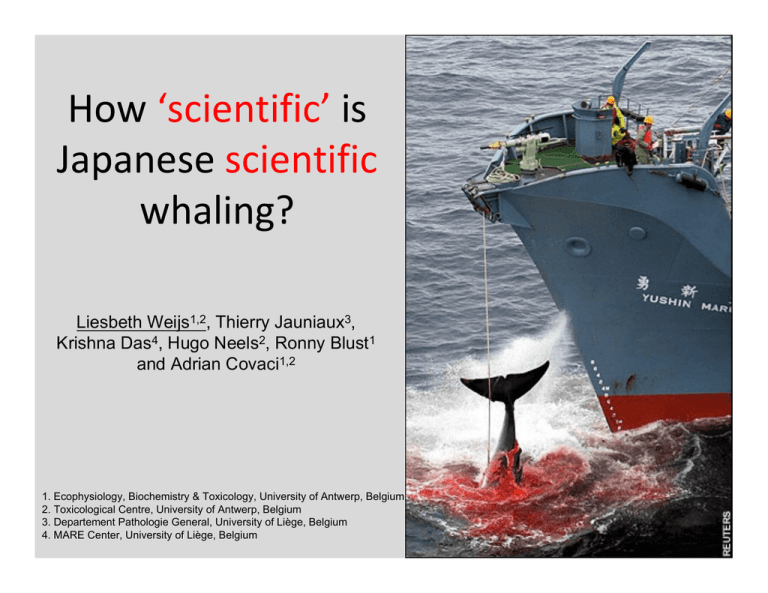
How ‘scientific’ is Japanese scientific whaling? Liesbeth Weijs1,2, Thierry Jauniaux3, Krishna Das4, Hugo Neels2, Ronny Blust1 and Adrian Covaci1,2 1. Ecophysiology, Biochemistry & Toxicology, University of Antwerp, Belgium 2. Toxicological Centre, University of Antwerp, Belgium 3. Departement Pathologie General, University of Liège, Belgium 4. MARE Center, University of Liège, Belgium Introduction IWC requests Japan to stop all lethal research Moratorium (zero catch quota) International Whaling Commission (IWC) Japanese Research Program under Special Permit in the western North Pacific JARPN I JARPN II 1999 1994 1988 1982 2005 JARPA II JARPA I Japanese Research Program under Special Permit in the Antarctic Scientific materials (only baleen whales!): 5519 + 11389 = 16908 23 years of scientific whaling, 16908 animals to investigate, but only 71 scientific (peer-reviewed) papers - 36 papers: ecology, pathology, genetics - 32 papers: reproduction biology (?!) - 3 papers: toxicology (butyltin – heavy metals – PCBs) Objectives ‘There is no doubt that whaling isn’t good for whales. What most people don’t know -and what pro-whaling nations such as Japan and Norway don’t want to consider- is that eating whale meat may be a human health hazard.’ The Humane Society of the United States, www.hsus.org How healthy is eating whale meat? Materials & Methods 22 September 2009: fin whale (Balaenoptera physalus) in Antwerp! Relevant? 28-06-2008 Michael Milstein, The Oregonian, USA Oregon State University researcher Scott Baker has uncovered victims of a hidden killing. The victims are endangered fin whales, the second-largest living animals in the world after blue whales. Using DNA fingerprinting, they discovered that the meat from Japan came from more fin whales than Japan has acknowledged killing. Results & Discussion On the menu Concentration (ng/g wet weight) Intake at low consumption rate* Intake at high consumption rate** PCBs (polychlorinated biphenyls) - Tolerable Intake (US EPA, 2002): 70 ng/kg/day Blubber 494 0.8 296.4 Muscle 127 0.2 76.2 DDTs (pesticides) - Tolerable Intake (US EPA, 2002): 500 ng/kg/day Blubber 357 0.6 214.2 Muscle 95 0.2 57.0 PBDEs (polybrominated diphenyl ethers) - Tolerable Intake (US EPA, 2002): 2000 ng/kg/day Blubber 22 0.04 13.2 Muscle 6 0.01 3.6 * Low consumption rate: (0.1 g/person/day or) 0.0017 g/kg body weight/day ** High consumption rate: (36 g/person/day or) 0.6 g/ kg body weight/day (Source: Simmonds et al., 2002) Conclusions Fin whales accumulate pollutants! (See also my poster n° 134) How healthy is eating whale meat? Japan doesn’t know….. or ….. Japanese scientists know, but do not communicate How ‘scientific’ is Japanese scientific whaling?

![Blue and fin whale populations [MM 2.4.1] Ecologists use the](http://s3.studylib.net/store/data/008646945_1-b8cb28bdd3491236d14c964cfafa113a-300x300.png)
